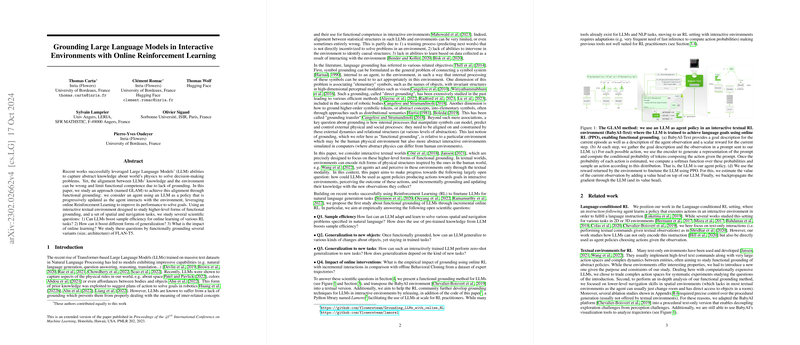Grounding LLMs in Interactive Environments with Online Reinforcement Learning
The paper "Grounding LLMs in Interactive Environments with Online Reinforcement Learning" presents a sophisticated approach named GLAM, aiming to align LLMs with interactive environments via functional grounding. The authors explore how this alignment can enhance sample efficiency, generalization capabilities, and intervention efficacy in reinforcement learning tasks using LLMs.
Summary of Key Concepts
Functional Grounding
The central theme of this research is functional grounding, defined as the alignment of an agent's internal symbolic processes with external dynamics, ensuring these symbols can effectively model, predict, and control interactions in an environment. The paper focuses particularly on textual environments where language acts as both the medium of perception and action.
Methodology
The methodology leverages recent advancements in transformer-based LLMs, using variants of FLAN-T5 to investigate their ability as policies in decision-making scenarios. The research utilizes an online reinforcement learning approach, specifically adapting the Proximal Policy Optimization (PPO) algorithm to finetune LLMs, enabling them to improve iteratively via interactions with the environment. The paper is conducted within BabyAI-Text, a novel textual interactive environment variant of the BabyAI platform designed to test higher-level grounding concepts.
Key questions addressed include whether LLMs can:
- Enhance sample efficiency in learning RL tasks.
- Generalize to new object configurations or tasks without direct training.
- Benefit from online interventions compared to offline strategies like Behavioral Cloning.
Experiments and Findings
Sample Efficiency
The investigation demonstrates that GLAM significantly improves the sample efficiency of LLMs in multivariate task settings compared to baseline models. This increased efficiency is attributed to the prior knowledge encoded within LLMs from their comprehensive pretraining on vast textual data. The method outperforms symbolic observation-based RL agents, highlighting the potential of LLMs to serve as rich prior models for RL tasks.
Generalization Capabilities
LLMs grounded through GLAM exhibit remarkable capabilities for zero-shot generalization. This includes successful adaptation to new objects and novel task compositions without explicit prior exposure, underpinning the robustness of LLMs in dynamically evolving interactive settings. The paper finds that the grounded LLM can handle out-of-vocabulary nouns and adjectives with minimal degradation in performance, thanks to their intrinsic ability to harness the learned high-dimensional semantic space.
Effect of Online Interventions
By comparing results from online reinforcement learning with those from Behavioral Cloning, the paper emphasizes the importance of interactive learning. The incremental interactions facilitated by online RL result in more proficient grounding, allowing LLMs to dynamically update their internal representations based on environmental feedback.
Implications and Future Directions
The implications of this research are multifaceted. Practically, the enhanced sample efficiency and generalization improvements emphasize the potential application of LLMs as decision-making agents in complex interactive environments. This could span use cases from robotic navigation to AI-driven gaming and beyond, where LLMs can directly leverage their understanding of semantics to inform action policies.
Theoretically, the research provides insights into the intersection of language grounding and RL, proposing mechanisms through which large-scale linguistic knowledge can be integrated into decision-making processes. The exploration of functional grounding in LLMs also opens avenues for future research focusing on multi-modal environments, potentially integrating visual and textual data to further enhance grounding fidelity.
Future work might explore scaling up the methodology to include even larger models or more complex environments, identifying limitations in current computational efficiencies. Moreover, the influence of functional grounding on an LLM's plasticity and ability to retain and transfer learned behaviors across varying environments warrants further exploration.
In conclusion, this paper offers a promising step toward integrating LLMs into the field of interactive reinforcement learning, providing insights and methodologies that pave the way for future advancements in the usage of LLMs in dynamic, decision-critical scenarios.
